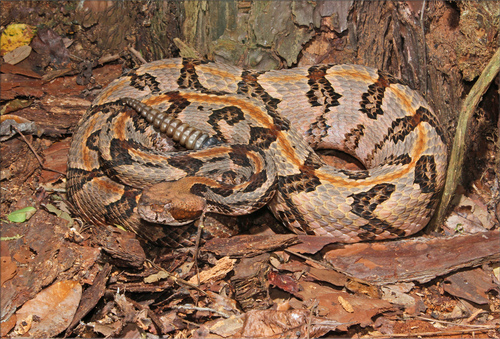
Timber Rattlesnake
The timber rattlesnake, Crotalus horridus, is a master of camouflage in North America's forests. Known for its distinctive rattle and striking patterned skin, it plays a crucial role in controlling rodent populations, showcasing nature's balance.
37 years
Lifespan
Length: 91 - 213 cm
Size
Least Concern
Conservation Status
Decreasing
Population Trend
Characteristics
Crotalus horridus, commonly known as the timber rattlesnake, is a venomous pit viper native to eastern North America. It inhabits deciduous forests and rugged terrain. Notable for its distinct rattle, it exhibits a color pattern of dark bands on a lighter background, varying from yellow to gray.
Distribution Range of the Timber Rattlesnake
Crotalus horridus, commonly known as the timber rattlesnake, is native to the eastern United States. Its geographical distribution extends from southern Minnesota and Wisconsin, eastward to southern New Hampshire and central Maine, and southward through the Appalachian Mountains to northern Georgia and northeastern Alabama. The species is also found in parts of the Mississippi River Valley, including Arkansas, Louisiana, and eastern Texas.
Timber Rattlesnake's Habitat
Environmental Conditions
The timber rattlesnake typically inhabits deciduous forests, mixed woodlands, and rocky hillsides. It is often associated with heavily wooded areas that provide ample cover and a diverse prey base. The species thrives in environments with moderate to high humidity and is often found in areas that offer both sunlit basking spots and shaded retreats. In more mountainous regions, it may be found at elevations ranging from lowlands up to 1,400 meters.
Ecological Niche
Crotalus horridus occupies a niche as a mid-to-top level predator within its ecosystem. It primarily preys on small mammals, such as mice, rats, and squirrels, as well as birds and amphibians. The species plays a crucial role in controlling the populations of these prey animals, contributing to the ecological balance of its habitat. The timber rattlesnake's preference for secluded forested areas helps it avoid human encounters, although habitat encroachment has increased the frequency of such interactions.
Copyright @ Nature Style Limited. All Rights Reserved.
 English
English